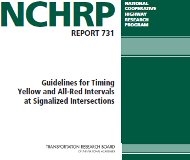Article from: www.thenewspaper.com/news/39/3941.asp
11/5/2012
Study Admits Yellow Times Too Short at Intersections
Transportation officials recommend adding 0.5 seconds of yellow time in new report.
 A report by state transportation officials released last week tacitly admitted drivers are being shortchanged when the light at an intersection turns yellow. The National Cooperative Highway Research Program (NCHRP) released its guidelines on how municipalities can best time their signals for safety. The net result is that most intersections would see yellows extended by roughly half-a-second if the recommendations were adopted.
A report by state transportation officials released last week tacitly admitted drivers are being shortchanged when the light at an intersection turns yellow. The National Cooperative Highway Research Program (NCHRP) released its guidelines on how municipalities can best time their signals for safety. The net result is that most intersections would see yellows extended by roughly half-a-second if the recommendations were adopted.
Signal timing has become a highly political issue due to lobbying by the National Motorists Association and the 2001 release of a report on the issue by the US House Majority Leader (view report). Various changes to the signal timing formula and other techniques have been used so that yellows are roughly one second shorter in the current Institute of Transportation Engineers (ITE) formula compared to what the prior formula used in 1976 generated. The states of Ohio and Georgia responded in the past three years by enacting laws mandating an extra second of yellow, resulting in a documented reduction in red light running. The NCHRP report admits the benefit of longer yellows.
"Increasing the yellow change interval to the duration calculated by current ITE guidelines has been shown to reduce red-light running occurrences between 36 and 50 percent," the report explained.
As the report detailed, there is no one standard system for determining yellow timing. Some states, such as Virginia, mandate the ITE methodology for intersections that have red light cameras. Other states spell out minimum standards in their regulations as codified in their state Manual on Uniform Traffic Control Devices (MUTCD). California, for example, says a 30 MPH intersection must have a yellow of no less than 3.2 seconds. A specific provision of California's red light camera law reminds traffic engineers that they may implement longer yellows, but not shorter yellows. Other states use a rule-of-thumb where the yellow duration is determined by dividing the speed limit by 10, so that a 30 MPH intersection has a 3.0 second yellow. The appendix of the new NCHRP report suggests the same 30 MPH intersection should have a 3.7 second minimum yellow time. For a 40 MPH intersection, California's minimum is 3.9 seconds, the rule-of-thumb is 4.0 seconds while NCHRP suggests it should be no less than 4.5 seconds.
NCHRP has not modified the current ITE formula to arrive at these figures. Instead, the researchers concede municipalities do not measure the actual speed of traffic when deciding how much time motorists need to stop safely when approaching an intersection. Instead, local engineers commonly plug the posted speed limit into an equation that needs the "85th percentile" speed to work properly. The 85th percentile is a measure of how fast at least 85 percent of traffic is flowing. The researchers also concede that traffic engineers tend to deliberately post speed limits far below the actual speed of traffic. This results in yellow times that are too short, as the researchers documented by studying actual intersections.
"For 3,632 vehicles sampled, the mean approach speed typically exceeded the speed limit at locations with a posted speed limit of 35 mph and below," the report determined. "However, at nearly all locations, the 85th percentile approach speed was found to exceed the posted speed limit... Therefore, speed limit in itself does not provide an accurate estimate of 85th percentile speed."
To remedy this, NCHRP recommends calculating yellow times at by adding 7 MPH to the posted speed limit to more closely approximate the actual speed of traffic. The NCHRP research was conducted by the Transportation Research Board of the National Academies and sponsored by the American Association of State Highway and Transportation Officials in cooperation with the Federal Highway Administration.
An excerpt from Appendix A of the report appears in a 650k PDF file at the source link below.
Article Excerpt:Yellow timing for given speed limit under the "rule-of-thumb" method, California's MUTCD and the new NCHRP method:
| MPH | Thumb | CA | NCHRP |
| 25 | 3.0 | 3.0 | 3.4 |
| 30 | 3.0 | 3.2 | 3.7 |
| 35 | 3.5 | 3.6 | 4.1 |
| 40 | 4.0 | 3.9 | 4.5 |
| 45 | 4.5 | 4.3 | 4.8 |
| 50 | 5.0 | 4.7 | 5.2 |
| 55 | 5.5 | 5.0 | 5.6 |
Source: Excerpt: Guidelines for Timing Yellow and All-Red Intervals (National Cooperative Highway Research Program, 10/28/2012)
Permanent Link for this item
Return to Front Page
 A report by state transportation officials released last week tacitly admitted drivers are being shortchanged when the light at an intersection turns yellow. The National Cooperative Highway Research Program (NCHRP) released its guidelines on how municipalities can best time their signals for safety. The net result is that most intersections would see yellows extended by roughly half-a-second if the recommendations were adopted.
A report by state transportation officials released last week tacitly admitted drivers are being shortchanged when the light at an intersection turns yellow. The National Cooperative Highway Research Program (NCHRP) released its guidelines on how municipalities can best time their signals for safety. The net result is that most intersections would see yellows extended by roughly half-a-second if the recommendations were adopted.